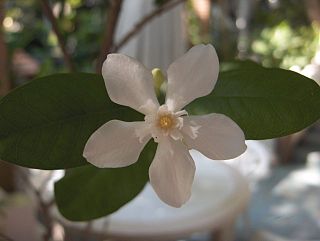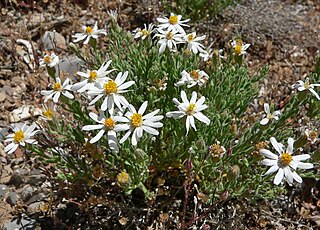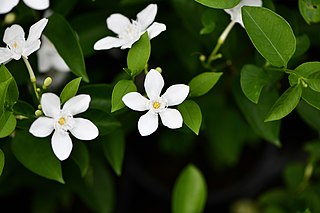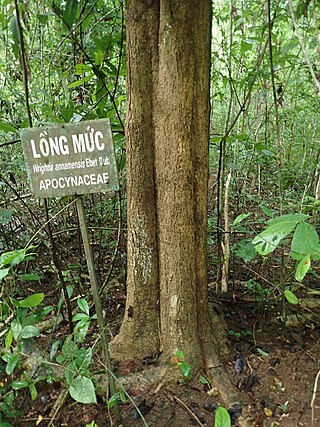
Apocynaceae is a family of flowering plants that includes trees, shrubs, herbs, stem succulents, and vines, commonly known as the dogbane family, because some taxa were used as dog poison. Members of the family are native to the European, Asian, African, Australian, and American tropics or subtropics, with some temperate members. The former family Asclepiadaceae is considered a subfamily of Apocynaceae and contains 348 genera. A list of Apocynaceae genera may be found here.

Wrightia is a genus of flowering plants in the family Apocynaceae, first described as a genus in 1810. It native to tropical Africa, China, the Indian Subcontinent, Southeast Asia, Papuasia, and Australia. The species are all small trees or shrubs.

William Wright (1735–1819) was a Scottish physician, botanist and slave owner. In 1783 he was a joint founder of the Royal Society of Edinburgh.
Wrightia laevis is a species of plant in the family Apocynaceae. It is found in Queensland (Australia), Cambodia, China, Indonesia, Laos, Malaysia, Burma, Papua New Guinea, the Philippines, Singapore, Thailand, and Vietnam.
Wrightia lanceolata is a species of plant in the family Apocynaceae. It is endemic to Thailand.
Wrightia lecomtei is a species of plant in the family Apocynaceae. It is found in Cambodia and Thailand in dry and evergreen forests. It is a shrub to small tree and can grow up to 5 m tall. Most plant parts are puberulent. Leaves are arranged oppositely along the stem; each leaf is 3 - 8 cm long by 2- 3.5 cm wide, oval to ovate shaped.
Wrightia viridiflora is a species of plant in the family Apocynaceae. It is endemic to Thailand.

Chaetopappa is a genus of plants in the family Asteraceae which are known generally as leastdaisies.

Cypella is a genus of herbaceous, perennial and bulbous plants in the family Iridaceae. It is distributed in South America, from Peru and Brazil to Northern Argentina. The genus name is likely derived from the Greek word kyphella, meaning "hollow of the ear", and alludes to the shape of the inner tepals.
Dichaetophora is a genus of flowering plants in the family Asteraceae.

Wrightia tinctoria, Pala indigo plant or dyer's oleander, is a flowering plant species in the genus Wrightia found in India, southeast Asia and Australia. It is found in dry and moist regions in its distribution. Various parts of the plant have been used in traditional medicine, but there is no scientific evidence it is effective or safe for treating any disease.

Wrightia antidysenterica, the coral swirl or tellicherry bark, is a flowering plant in the genus Wrightia. Wrightia antidysenterica is sometimes confused with the species Holarrhena pubescens due to a second, taxonomically invalid publication of the name Holarrhena pubescens. It is known in Sanskrit as kuṭaja or ambikā.
Wrightia demartiniana is a plant in the dogbane family Apocynaceae.
Erigeron geiseri is a North American species of flowering plants in the family Asteraceae known by the common name Geiser's fleabane.

Wrightia religiosa is a species of tree in the family Apocynaceae. Its distribution includes: China (Guangdong), Indochina and Malaysia including the Philippines; no subspecies are listed in the Catalogue of Life.

Wrightia annamensis is a small tree species in the family Apocynaceae. Its distribution includes: southern China, Cambodia and Viet Nam: where it may be called: lòng mức trung bộ.

Wrightia pubescens is a species of small tree in the family Apocynaceae. Its distribution includes: Australia, southern China, Taiwan (introduced), Indonesia, New Guinea, Philippines and Indo-China. In Viet Nam, it may be called: lòng mức lông.

Wrightia dubia is a species of shrub-plant in the family Apocynaceae. Its distribution includes: Indo-China and peninsular Malaysia ; no subspecies are listed in the Catalogue of Life. In Viet Nam, it may be called lòng mức ngờ.

Wrightia arborea, the woolly dyeing rosebay, is a species of flowering plant in the family Apocynaceae. It is native to the Indian Subcontinent, Southeast Asia, and southern China. A tree reaching 20 m (66 ft), local peoples use it for timber and as the source of a dye.












